Abstract
Following electroconvulsive shock (ECS) administration daily for 10 days there was an increase (35%) in 5-hydroxytryptamine2 (5-HT2) receptor number in rat frontal cortex 24 h after the last ECS, compared with handled controls. A similar increase was seen after intermittent ECS administration (5 ECS over 10 days) given during halothane anaesthesia, compared with halothane-treated controls. The dissociation constant was also increased at this time. A single ECS had no effect. Treatment of rats with pentylenetetrazol, p-chlorophenylalanine or alpha-methyl p-tyrosine during the intermittent ECS administration abolished the increase in 5-HT2 receptor binding. Since enhanced 5-HT-mediated behavioural responses are seen after repeated ECS but not when the ECS is given with the drug treatments outlined above, it is suggested that ECS-induced enhancement of 5-HT-mediated behaviour results from an increase in 5-HT2 receptor number.
Full text
PDF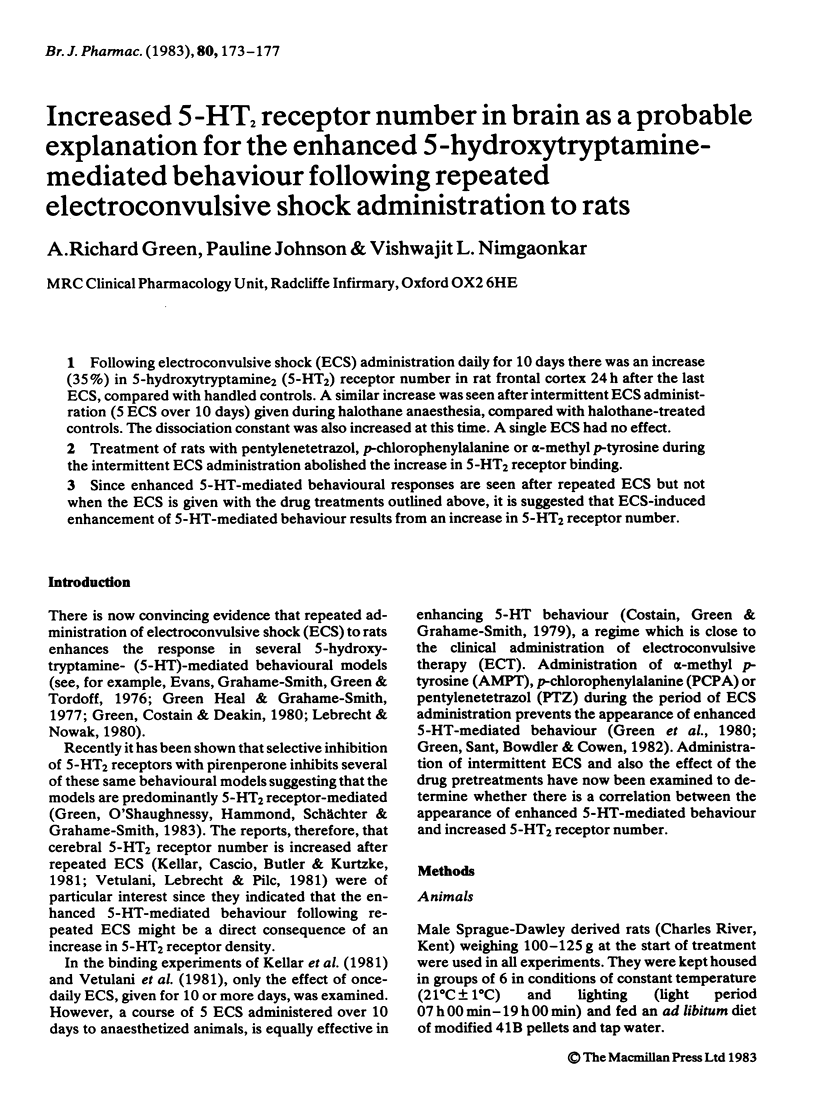
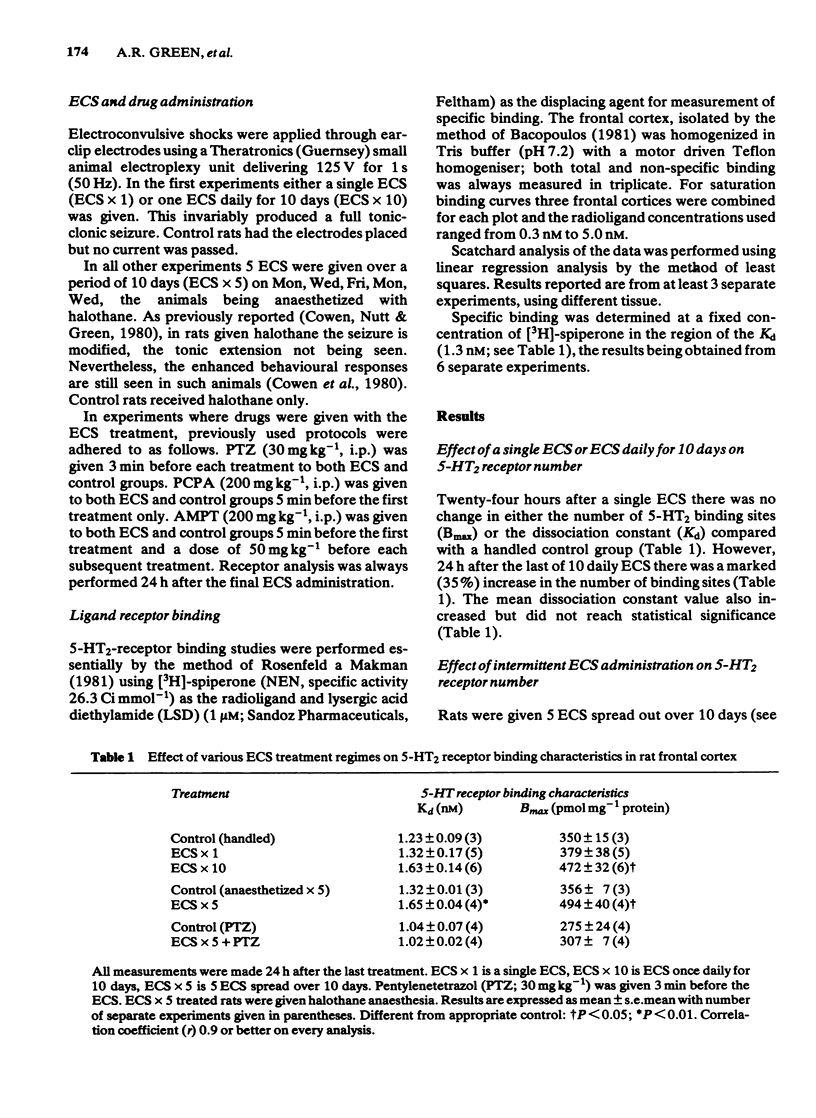
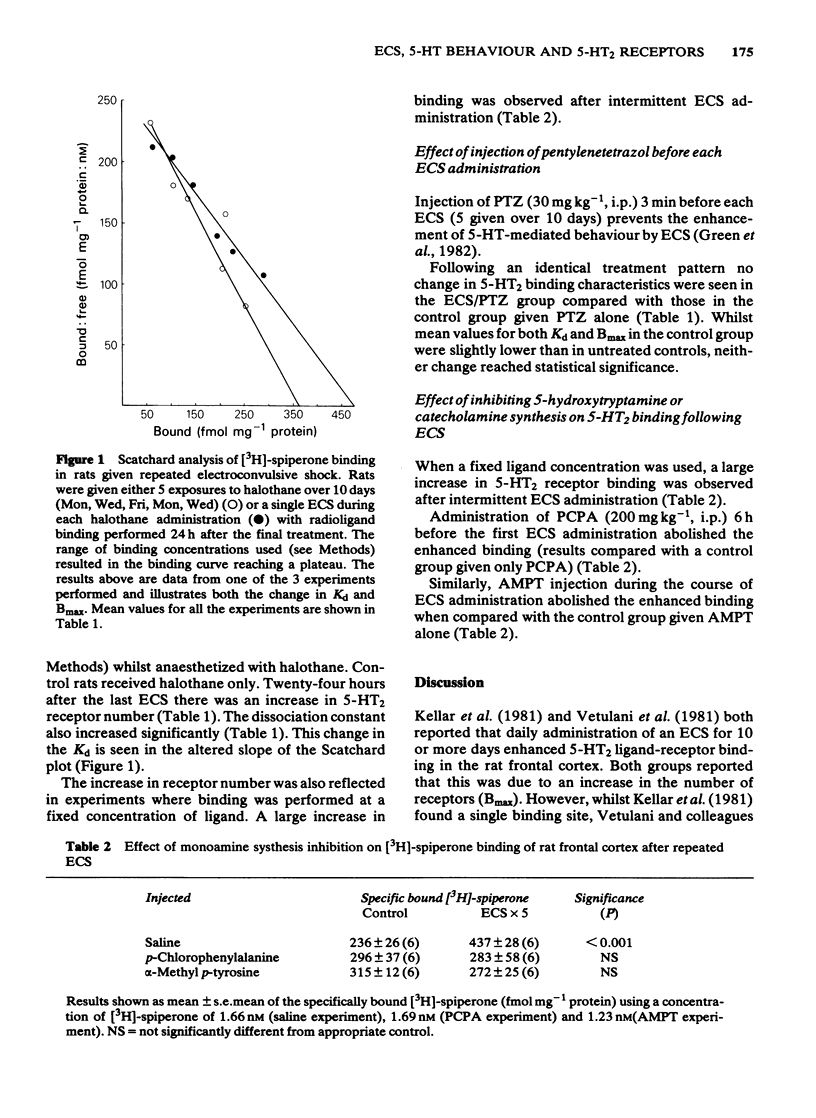
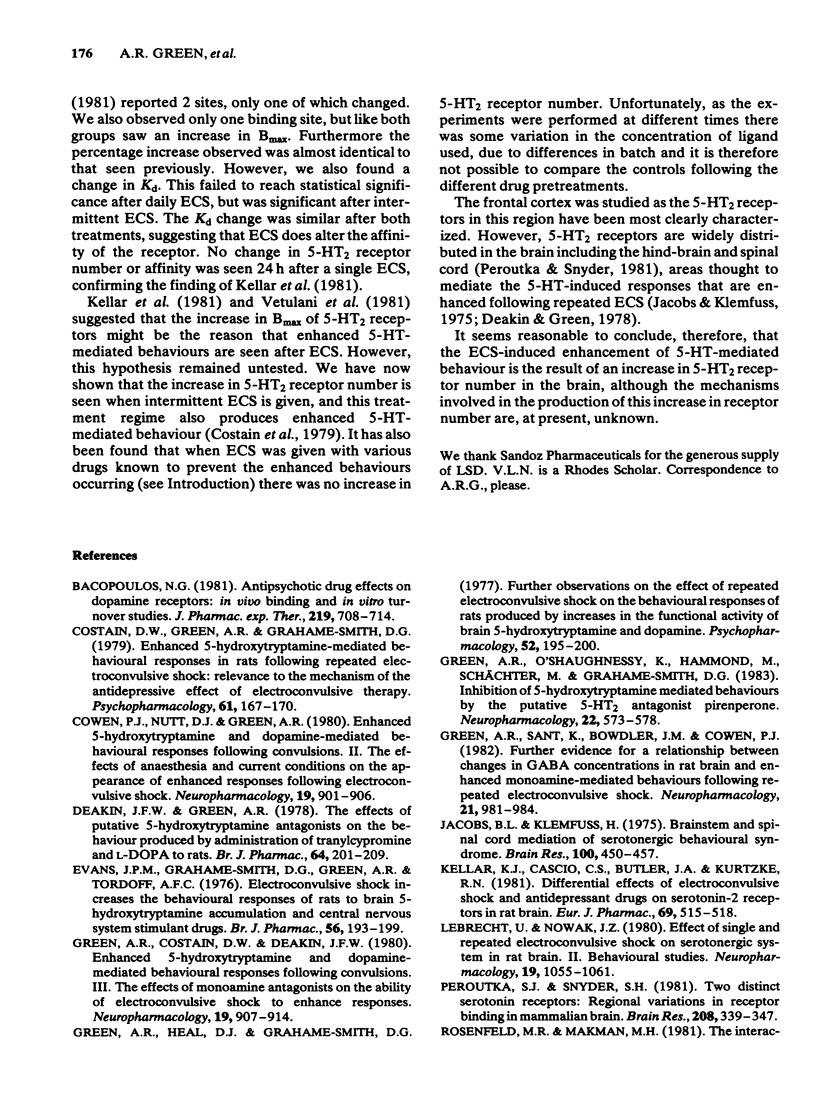
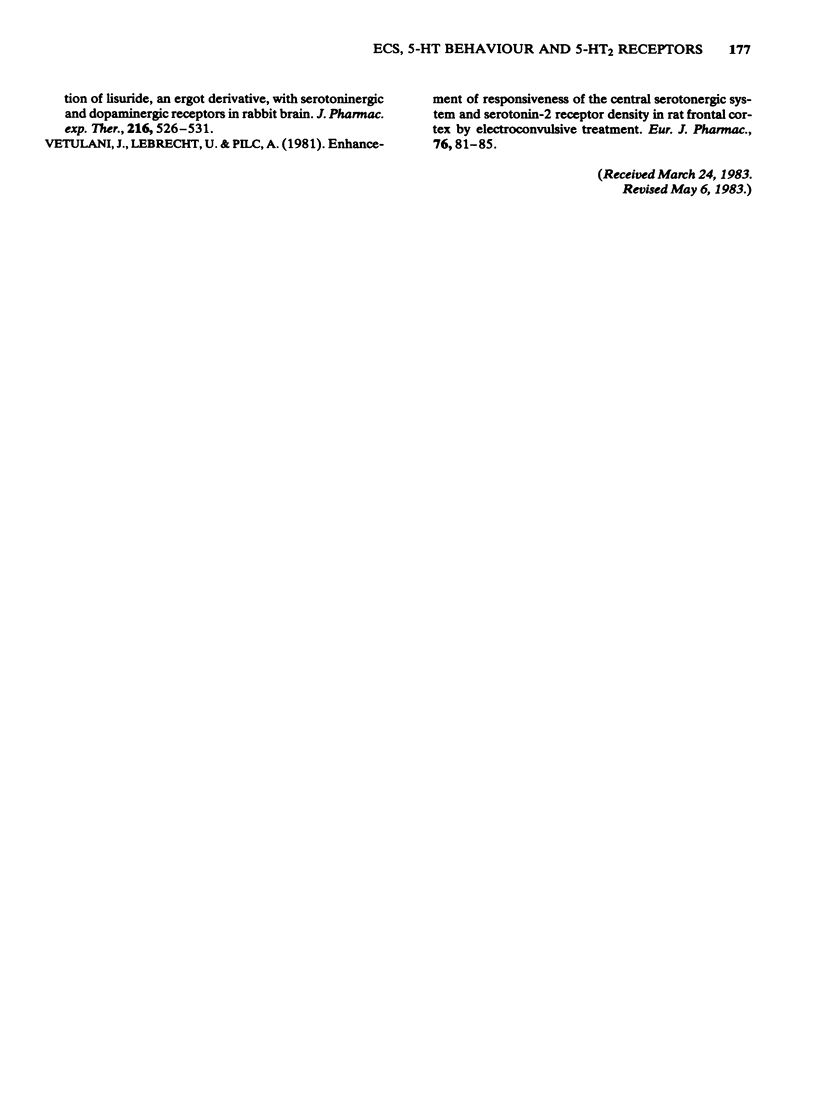
Selected References
These references are in PubMed. This may not be the complete list of references from this article.
- Bacopoulos N. G. Antipsychotic drug effects on dopamine and serotonin receptors: in vitro binding and in vivo turnover studies. J Pharmacol Exp Ther. 1981 Dec;219(3):708–714. [PubMed] [Google Scholar]
- Costain D. W., Green A. R., Grahame-Smith D. G. Enhanced 5-hydroxytryptamine-mediated behavioural responses in rats following repeated electroconvulsive shock: relevance to the mechanism of the antidepressive effect of electroconvulsive therapy. Psychopharmacology (Berl) 1979 Mar 22;61(2):167–170. doi: 10.1007/BF00426732. [DOI] [PubMed] [Google Scholar]
- Cowen P. J., Nutt D. J., Green A. R. Enhanced 5-hydroxytryptamine and dopamine-mediated behavioural responses following convulsions--II. The effects of anaesthesia and current conditions on the appearance of enhanced responses following electroconvulsive shock. Neuropharmacology. 1980 Sep;19(9):901–906. doi: 10.1016/0028-3908(80)90091-x. [DOI] [PubMed] [Google Scholar]
- Deakin J. F., Green A. R. The effects of putative 5-hydroxytryptamine antagonists on the behaviour produced by administration of tranylcypromine and L-tryptophan or tranylcypromine and L-DOPA to rats. Br J Pharmacol. 1978 Oct;64(2):201–209. doi: 10.1111/j.1476-5381.1978.tb17290.x. [DOI] [PMC free article] [PubMed] [Google Scholar]
- Evans J. P., Grahame-Smith D. G., Green A. R., Tordoff A. F. Electroconvulsive shock increases the behavioural responses of rats to brain 5-hydroxytryptamine accumulation and central nervous system stimulant drugs. Br J Pharmacol. 1976 Feb;56(2):193–199. doi: 10.1111/j.1476-5381.1976.tb07442.x. [DOI] [PMC free article] [PubMed] [Google Scholar]
- Green A. R., Costain D. W., Deakin J. F. Enhanced 5-hydroxytryptamine and dopamine-mediated behavioural responses following convulsions--III. The effects of monoamine antagonists and synthesis inhibitors on the ability of electroconvulsive shock to enhance responses. Neuropharmacology. 1980 Sep;19(9):907–914. doi: 10.1016/0028-3908(80)90092-1. [DOI] [PubMed] [Google Scholar]
- Green A. R., Heal D. J., Grahame-Smith D. G. Further observations on the effect of repeated electroconvulsive shock on the behavioural responses of rats produced by increases in the functional activity of brain 5-hydroxytryptamine and dopamine. Psychopharmacology (Berl) 1977 Apr 29;52(2):195–200. doi: 10.1007/BF00439110. [DOI] [PubMed] [Google Scholar]
- Green A. R., O'Shaughnessy K., Hammond M., Schächter M., Grahame-Smith D. G. Inhibition of 5-hydroxytryptamine-mediated behaviour by the putative 5-HT2 antagonist pirenperone. Neuropharmacology. 1983 May;22(5):573–578. doi: 10.1016/0028-3908(83)90147-8. [DOI] [PubMed] [Google Scholar]
- Green A. R., Sant K., Bowdler J. M., Cowen P. J. Further evidence for a relationship between changes in GABA concentration in rat brain and enhanced monoamine-mediated behavioural responses following repeated electroconvulsive shock. Neuropharmacology. 1982 Oct;21(10):981–984. doi: 10.1016/0028-3908(82)90110-1. [DOI] [PubMed] [Google Scholar]
- Jacobs B. L., Klemfuss H. Brain stem and spinal cord mediation of a serotonergic behavioral syndrome. Brain Res. 1975 Dec 19;100(2):450–457. doi: 10.1016/0006-8993(75)90500-4. [DOI] [PubMed] [Google Scholar]
- Kellar K. J., Cascio C. S., Butler J. A., Kurtzke R. N. Differential effects of electroconvulsive shock and antidepressant drugs on serotonin-2 receptors in rat brain. Eur J Pharmacol. 1981 Feb 19;69(4):515–518. doi: 10.1016/0014-2999(81)90460-x. [DOI] [PubMed] [Google Scholar]
- Lebrecht U., Nowak J. Z. Effect of single and repeated electroconvulsive shock on serotonergic system in rat brain--II. Behavioural studies. Neuropharmacology. 1980 Nov;19(11):1055–1061. doi: 10.1016/0028-3908(80)90101-x. [DOI] [PubMed] [Google Scholar]
- Peroutka S. J., Snyder S. H. Two distinct serotonin receptors: regional variations in receptor binding in mammalian brain. Brain Res. 1981 Mar 16;208(2):339–347. doi: 10.1016/0006-8993(81)90562-x. [DOI] [PubMed] [Google Scholar]
- Rosenfeld M. R., Makman M. H. The interaction of lisuride, an ergot derivative, with serotonergic and dopaminergic receptors in rabbit brain. J Pharmacol Exp Ther. 1981 Mar;216(3):526–531. [PubMed] [Google Scholar]
- Vetulani J., Lebrecht U., Pilc A. Enhancement of responsiveness of the central serotonergic system and serotonin-2 receptor density in rat frontal cortex by electroconvulsive treatment. Eur J Pharmacol. 1981 Nov 19;76(1):81–85. doi: 10.1016/0014-2999(81)90012-1. [DOI] [PubMed] [Google Scholar]


